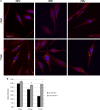Astrocytes infected with Chlamydia pneumoniae demonstrate altered expression and activity of secretases involved in the generation of β-amyloid found in Alzheimer disease
- PMID: 30786875
- PMCID: PMC6383264
- DOI: 10.1186/s12868-019-0489-5
Astrocytes infected with Chlamydia pneumoniae demonstrate altered expression and activity of secretases involved in the generation of β-amyloid found in Alzheimer disease
Abstract
Background: Epidemiologic studies strongly suggest that the pathophysiology of late-onset Alzheimer disease (AD) versus early-onset AD has environmental rather than genetic causes, thus revealing potentially novel therapeutic targets to limit disease progression. Several studies supporting the "pathogen hypothesis" of AD demonstrate a strong association between pathogens and the production of β-amyloid, the pathologic hallmark of AD. Although the mechanism of pathogen-induced neurodegeneration of AD remains unclear, astrocytes, a key player of the CNS innate immune response and producer/metabolizer of β-amyloid, have been implicated. We hypothesized that Chlamydia pneumoniae infection of human astrocytes alters the expression of the amyloid precursor protein (APP)-processing secretases, ADAM10, BACE1, and PSEN1, to promote β-amyloid formation. Utilizing immunofluorescent microscopy, molecular, and biochemical approaches, these studies explore the role of an intracellular respiratory pathogen, Chlamydia pneumoniae, as an environmental trigger for AD pathology. Human astrocytoma cells in vitro were infected with Chlamydia pneumoniae over the course of 6-72 h. The gene and protein expression, as well as the enzymatic activity of non-amyloidogenic (ADAM10), and pro-amyloidogenic (BACE1 and PSEN1) secretases were qualitatively and quantitatively assessed. In addition, the formation of toxic amyloid products as an outcome of pro-amyloidogenic APP processing was evaluated through various modalities.
Results: Chlamydia pneumoniae infection of human astrocytoma cells promoted the transcriptional upregulation of numerous genes implicated in host neuroinflammation, lipid homeostasis, microtubule function, and APP processing. Relative to that of uninfected astrocytes, BACE1 and PSEN1 protein levels were enhanced by nearly twofold at 48-72 h post-Chlamydia pneumoniae infection. The processing of APP in Chlamydia pneumoniae-infected astrocytes favors the pro-amyloidogenic pathway, as demonstrated by an increase in enzymatic activity of BACE1, while that of ADAM10 was decreased. Fluorescence intensity of β-amyloid and ELISA-quantified levels of soluble-APP by products revealed temporally similar increases, confirming a BACE1/PSEN1-mediated processing of APP.
Conclusions: Our findings suggest that Chlamydia pneumoniae infection of human astrocytes promotes the pro-amyloidogenic pathway of APP processing through the upregulation of expression and activity of β-secretase, upregulated expression of γ-secretase, and decreased activity of α-secretase. These effects of astrocyte infection provide evidence for a direct link between Chlamydia pneumoniae and AD pathology.
Keywords: Alzheimer disease; Amyloid; Astrocytes; BACE1; Chlamydia pneumoniae; Neurodegeneration; Neuroinflammation; Pathogens; Secretase.
Figures







Similar articles
-
Gallic acid is a dual α/β-secretase modulator that reverses cognitive impairment and remediates pathology in Alzheimer mice.J Biol Chem. 2020 Nov 27;295(48):16251-16266. doi: 10.1074/jbc.RA119.012330. Epub 2020 Sep 10. J Biol Chem. 2020. PMID: 32913125 Free PMC article.
-
Beta-secretase/BACE1 promotes APP endocytosis and processing in the endosomes and on cell membrane.Neurosci Lett. 2018 Oct 15;685:63-67. doi: 10.1016/j.neulet.2018.08.016. Epub 2018 Aug 16. Neurosci Lett. 2018. PMID: 30120949
-
C6 Glioma-Secreted NGF and FGF2 Regulate Neuronal APP Processing Through Up-Regulation of ADAM10 and Down-Regulation of BACE1, Respectively.J Mol Neurosci. 2016 Jul;59(3):334-42. doi: 10.1007/s12031-015-0690-7. Epub 2015 Nov 27. J Mol Neurosci. 2016. PMID: 26614345
-
BACE1: the beta-secretase enzyme in Alzheimer's disease.J Mol Neurosci. 2004;23(1-2):105-14. doi: 10.1385/JMN:23:1-2:105. J Mol Neurosci. 2004. PMID: 15126696 Review.
-
The beta-secretase, BACE: a prime drug target for Alzheimer's disease.J Mol Neurosci. 2001 Oct;17(2):157-70. doi: 10.1385/JMN:17:2:157. J Mol Neurosci. 2001. PMID: 11816789 Review.
Cited by
-
Association Between Antibiotic Treatment of Chlamydia pneumoniae and Reduced Risk of Alzheimer Dementia: A Nationwide Cohort Study in Taiwan.Front Aging Neurosci. 2021 Aug 18;13:701899. doi: 10.3389/fnagi.2021.701899. eCollection 2021. Front Aging Neurosci. 2021. PMID: 34489674 Free PMC article.
-
Chlamydia pneumoniae can infect the central nervous system via the olfactory and trigeminal nerves and contributes to Alzheimer's disease risk.Sci Rep. 2022 Feb 17;12(1):2759. doi: 10.1038/s41598-022-06749-9. Sci Rep. 2022. PMID: 35177758 Free PMC article.
-
Pharmacological Inhibition of Amyloidogenic APP Processing and Knock-Down of APP in Primary Human Macrophages Impairs the Secretion of Cytokines.Front Immunol. 2020 Sep 3;11:1967. doi: 10.3389/fimmu.2020.01967. eCollection 2020. Front Immunol. 2020. PMID: 33013850 Free PMC article.
-
MiR-29c-3p May Promote the Progression of Alzheimer's Disease through BACE1.J Healthc Eng. 2021 Dec 15;2021:2031407. doi: 10.1155/2021/2031407. eCollection 2021. J Healthc Eng. 2021. PMID: 34956559 Free PMC article.
-
The Role of Genetic, Environmental, and Dietary Factors in Alzheimer's Disease: A Narrative Review.Int J Mol Sci. 2025 Jan 30;26(3):1222. doi: 10.3390/ijms26031222. Int J Mol Sci. 2025. PMID: 39940989 Free PMC article. Review.
References
Publication types
MeSH terms
Substances
LinkOut - more resources
Full Text Sources
Medical

